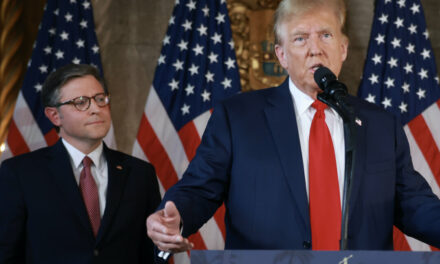We support our Publishers and Content Creators. You can view this story on their website by CLICKING HERE.
Key Democrat calls on Biden administration, Congress to boost funding if US is to remain the world leader in emerging energy technology.
Despite advances in the last two years, the federal government’s fiscal year 2025 budget falls short of annual allocations outlined in 2021’s CHIPS and Science Act and funding requests from industry leaders for fusion energy research and development.
Rep. Zoe Lofgren (D-Calif.) is calling on Congress to find the money to meet those benchmarks if the United States is to remain the global leader in developing what some call the “holy grail” in emerging energy technologies.
The administration and Congress must “get these programs on a much stronger footing at this critical juncture for the budding U.S. fusion industry,” she told Department of Energy (DOE) Deputy Secretary David Turk during a June 26 hearing on the department’s proposed $51.42 billion fiscal 2025 budget before the House Science, Space, and Technology Committee.
DOE’s proposed $844.5 million allocation for fusion energy programs is an increase of 6.9 percent, or $54.5 million, from this year’s budget but falls short of the $1 billion proponents say is needed per annum.
It’s the second year in a row that fusion development funding falls shy of the $1 billion annually authorized under 2021’s CHIPS and Science Act, which is supported by DOE’s Fusion Energy Science Advisory Committee and the 71-member House Fusion Caucus.
The fiscal year 2024 DOE Office of Science budget allocated $778 million for its Fusion Energy Sciences (FEC) program,.
Ms. Lofgren, the House Science, Space, and Technology Committee ranking Democrat and a member of the fusion caucus said she is “excited about the real breakthroughs we’ve seen in fusion over the last two years” and “the rapid growth we’re seeing in the private sector for fusion” fueled by $6 billion in investments, but it doesn’t appear that the administration shares the enthusiasm.
That, she said, is short-sighted.
Unlike fission, nuclear fusion replicates the reaction produced by fusing atoms, which is the power generated by the sun. Proponents say it has the potential to provide limitless, clean energy and is often referred to as “the holy grail of energy solutions.”
Fusion has been researched by academic institutions and government laboratories since the 1950s with significant advances in the last two years.
There is a global race to harness fusion energy. The International Atomic Energy Agency oversees worldwide fusion partnerships and research. The International Thermonuclear Experimental Reactor, a collaboration between six countries and the European Union in France, is one of the largest scientific experiments in history.
In May 2023, DOE awarded $46 million to eight fusion reactor developers under its public-private Milestone program. In December 2023, DOE announced a $42 million program to create three advance fusion energy hubs.
The House adopted the Fusion Energy Act in February. It awaits committee hearings in the Senate.
The bill codifies the Nuclear Regulatory Commission’s (NRC) regulatory framework licensing commercial fusion devices and requires NRC to report to Congress on its plans to expedite the licensing process.
“The fusion science program continues to face a more than $200 million shortfall, and DOE’s proposal for a stepped-up research network—now dubbed Fusion Innovation Research Engine (FIRE) centers—remains unfunded,” it noted.
“Despite the best efforts of me and many of my colleagues on both sides of the aisle, I was deeply disappointed that Congress’s appropriations process failed to match or, frankly, come anywhere close to the request, and I’m further disappointed that DOE’s budget proposal for fusion in 2025 appears to be actually a step backward,” Ms. Lofgren told Mr. Turk.
Of particular concern, she said, is a 25 percent slash in funding for the Milestone program.
Despite the funding “headwinds” fostered by the Fiscal Responsibility Act (FRA) caps of July 2023,“We still have a long way to go before our final budget gets to the president’s desk and I only see bipartisan support for this enterprise growing in the months and years to come,” Ms. Lofgren said.
‘Budget-Constrained World’
“Fusion is a technology that’s a top priority to many of us,” agreed Mr. Turk, describing himself as “a huge fusion fan.”
He said the administration is enthused about the $6 billion in private investments for fusion research and development.
“There’s a historic opportunity here for us,” Mr. Turk said. “We need to think about orders of magnitude, more on the fusion funding side of things. There’s a competition going on right now.”
Mr. Turk said there could be money added for fusion programs when House Republicans submit their version of the energy budget in coming weeks.
Unless that happens, he said, the administration’s spending request is tailored to the realities of the day.
“So, candidly speaking, when we look at where Congress has provided us money previously, we try to make as much headroom as we possibly can in a very budget-constrained world for an awful lot of priorities,” Mr. Turk said. “And so, that’s what you see reflected in FY25 requests.”
Ms. Lofgren noted the Fusion Industry Association recently submitted a proposal for a $3 billion supplemental appropriation “to support a specific set of facilities, programs, and research activities that would allow the U.S. to be the world leader in the emerging fusion industry.”
Their request is similar to “the proposed billions” the administration has earmarked for nuclear fuel research and production, she said.
“I’m very intrigued with their proposal,” Mr. Turk said. With China’s spending $1.5 billion a year on fusion, “we’ve got a real opportunity to make sure we are leaders, continue to be leaders in this space, which we are right now. I think $3 billion in a supplemental context is very appropriate.”
There are eight companies in the Milestone program working on the FIRE collaboratives, Ms. Lofgren said, and the $3 billion would be vital to making progress.
“I’ll just note that we are the leader in fusion now,” she said, noting DOE, the caucus, and advisory committee had a “bold plan” that isn’t being funded to meet its objectives.
Instead, Ms. Lofgren said, “China funded the plan. So, if we don’t get ahead of this, we’re not only going to lose in terms of [leading] the world, but we’re going to lose to China, once again, because of our lack of vision. And I think it’s a terrible shame.”
“Well said, ranking member,” Committee Chair Rep. Frank Lucas (R-Okla.) said.

 Conservative
Conservative  Search
Search Trending
Trending Current News
Current News 







